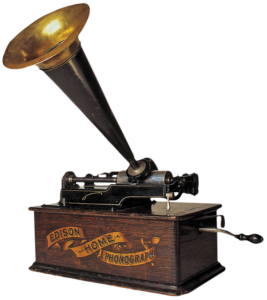The field of audiology has come a long way in just the past 150 years. There are far more resources to assist sufferers of hearing loss than ever before. From standardized hearing exams, to a renewed understanding of contributing factors to hearing damage, there has never been more support than in the present day. One of the most significant audiological strides of the past century has been the advancing of assistive listening devices. Today, we’d like to give you a brief history of their conception and development.

Have you ever wondered how modern hearing aids were developed? Here’s a brief history of assistive listening devices.
Origins: Ear Trumpets
Even as early as the thirteenth century, there was one form of assistive listening devices for the hard of hearing: ear trumpets. You may have seen these in cartoons, old films, or museums. They are (or were) exactly what they sound like—funnel-shaped tubes that helped to direct sound to your ear.
These were the only form of assistive available to individuals with hearing loss until as recently as the nineteenth century. As you might expect, they didn’t work very well. But they were no doubt helpful for speaking to your elderly relatives at a noisy dinner table.
The Earliest Hearing Aids
Not long after Alexander Graham Bell invented the telephone, people began to recognize the technology’s capacity for improving hearing. Sufferers of hearing loss in the late nineteenth century found that they had an easier time hearing individuals through a phone’s receiver than in person. Thomas Edison was one of those people, so he invented a device that would amplify sound. That’s how the very first hearing aids came to be.
As the field of audiology developed, so too did these assistive listening devices. One significant development was the implementation of vacuum tubes, which further improved the amplification capacity of early hearing aids. For most of the rest of the twentieth century, the main task audiologists faced was making these bulky devices more portable.
Modern-Day Hearing Aids
We can trace the prototype of the modern-day hearing aid to 1996, when they made the shift from analog to digital. From then on, the technology continued to improve dramatically. In the present day, audiologists can customize your hearing aids to suit your particular needs. After all, no two instances of hearing loss are precisely alike. They are no longer bulky or uncomfortable, and can adapt to different levels of ambient noise.
Suffering from hearing loss is not easy. But we are exceptionally fortunate to live in 2020, when advances in assistive listening devices will only continue to improve.
Contact Bay Area Audiology Today
Ready to change the way you look at hearing loss? Our Doctor of Audiology, Dr. Trisha A. Bents Muth, is exceptionally experienced in the art of audiology and is dedicated to providing the absolute best solutions. Bay Area Audiology has been working to give patients a comfortable environment with thorough evaluations. We are independently owned, and unbiased when it comes to finding you the care you need.
You can always come into the office or contact us in advance to set up an appointment. We also provide updates on our social media websites. You can check out our Facebook, Twitter, LinkedIn, and Pinterest to keep up with Bay Area Audiology.
Don’t hesitate–we can help.
